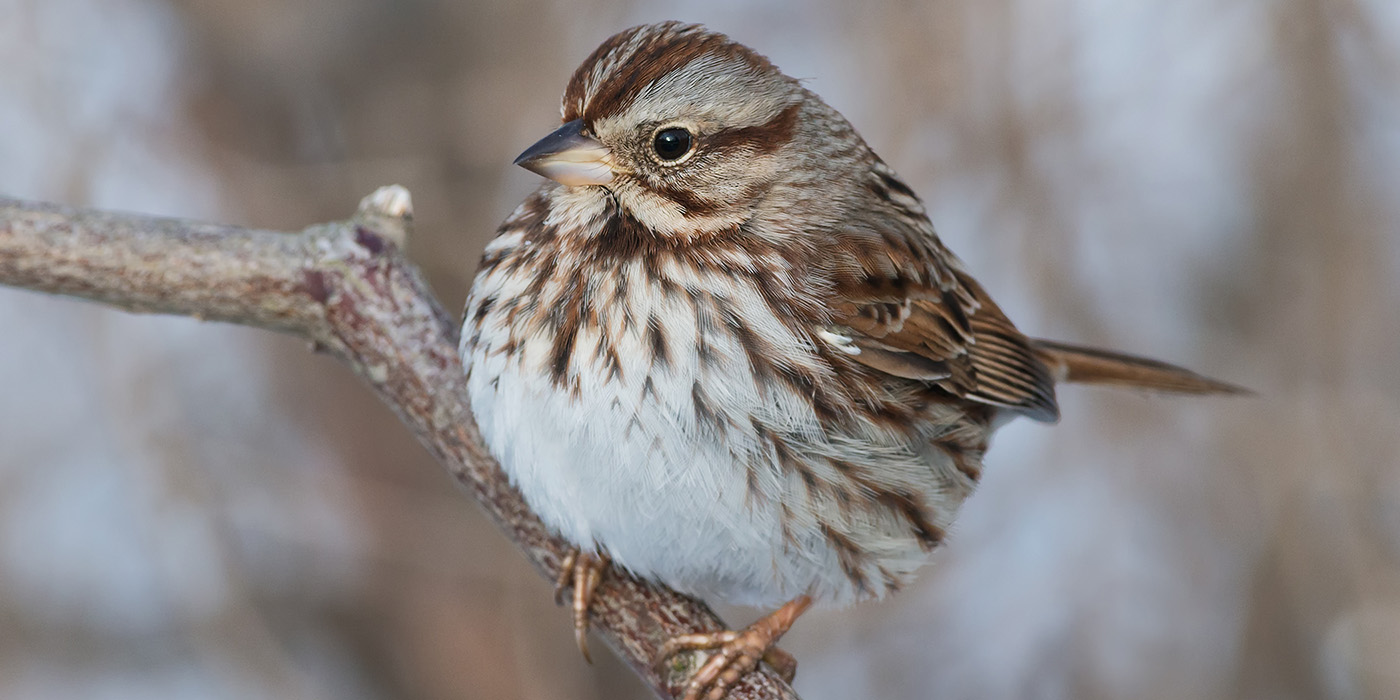Study is first to directly link cognitive power to a physical response to warming
By Talia Ogliore

Among North American migratory birds, bigger-brained birds like the song sparrow did not change in size as much smaller-brained birds that experienced the same amount of warming, according to new research from Washington University in St. Louis. (Photo: Shutterstock)
Many North American migratory birds are shrinking in size as temperatures have warmed over the past 40 years. But those with very big brains, relative to their body size, did not shrink as much as smaller-brained birds, according to new research from Washington University in St. Louis. The study is the first to identify a direct link between cognition and animal response to human-made climate change.
The body size changes in songbirds are small but significant, affecting familiar species of sparrows, warblers and thrushes. In fact, the size changes are so pervasive that some scientists have suggested that reductions are a universal response to warming. But new research published in Ecology Letters shows that bigger-brained birds have been able to out-think shrink, at least to a certain extent.
“As temperatures warm, body sizes are decreasing,” said Justin Baldwin, a PhD candidate in the laboratory of Carlos Botero, assistant professor of biology in Arts & Sciences at Washington University. “But larger-brained species are declining less strongly than small-brained species.”
Baldwin and his co-authors analyzed information on some 70,000 birds that died when they collided with buildings in Chicago from 1978 to 2016. They augmented this vast dataset, first published by researchers at the University of Michigan, with new brain volume measurements and lifespan data for 49 of the 52 species of North American migratory birds included in the original study.
Birds that had very big brains, relative to their bodies, had body size reductions that were only about one-third of those observed for birds with smaller brains, the Washington University scientists discovered.
And bigger brains matter for birds.
Relative brain size is often considered a proxy for behavioral flexibility in birds. The idea is controversial when it is applied to some other animals, Baldwin said, but it works well for birds.
“Relative brain size correlates with increased learning ability, increased memory, longer lifespans and more stable population dynamics,” Baldwin said.
“In this case, a bigger-brained species of bird might be able to reduce its exposure to warming temperatures by seeking out microhabitats with cooler temperatures, for example,” he said.
The new findings are significant because this is the first time scientists have been able to show a direct link between cognition and phenotypic responses to climate change.
More or better options
It’s not entirely clear why so many songbirds are shrinking in size as temperatures rise. One possible explanation is that heat causes stress, and birds with smaller bodies can dissipate heat better. This explanation is consistent with observations that birds that live in the warmer parts of their species’ normal geographic ranges are smaller than those that live in the colder parts of their range.
But downsizing comes at a potential fitness cost — e.g., increased predation or reduced competitive ability — that birds in general may want to avoid. In that context, having a larger brain may offer alternatives that are not available to small-brained species.
“One of the first things that jumps out to me from these findings is that we can already see that climate change is having a disproportionate effect on species that have less capacity to deal with environmental change through their behavior,” Botero said.
“This doesn’t mean that climate change is not affecting brainy birds,” Botero said, “or that brainy birds are going to do just fine. What our findings suggest is that climate change can have a much stronger effect on the less-brainy birds.”
“The species we studied only spanned a two-fold difference in relative brain size, which was enough to reduce the effects of increases in breeding temperature by 70 percent,” Baldwin said. “This tells us that even small differences in cognition matter.”
The findings also have practical implications for conservation, as 3 billion birds (about one in three) have been lost in North America since the 1970s. “That’s probably a lot of natural selection that hits different species differently,” Baldwin said.
“Rapid changes in the environment often produce a few winners and a whole lot of losers, which is really unfortunate,” he said. “Many wildlife populations have moved toward colder places as the planet has warmed. Selection forces those that don’t move to adapt, for example, by changing their body size.
Baldwin’s analysis reveals that smaller-brained species might be under especially strong natural selection, a fact that planners may need to take into account for conservation management.
“When it comes to climate change mitigation and planning, a major goal is to maintain population-level connectivity,” Baldwin said. “We want to allow species to move toward the poles or upslope in elevation, to keep up with warming climates. Our findings suggest that this type of intervention could be especially important for smaller-brained species.”